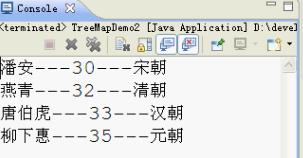Java基础知识强化之集合框架笔记60:Map集合之TreeMap(TreeMap<Student,String>)的案例
2015-10-09 21:41
826 查看
1. TreeMap(TreeMap<Student,String>)的案例
2. 案例代码:
(1)Student.java:
(2)测试类TreeMapDemo2,如下:
运行效果,如下:

2. 案例代码:
(1)Student.java:
package cn.itcast_04;
public class Student {
private String name;
private int age;
public Student() {
super();
}
public Student(String name, int age) {
super();
this.name = name;
this.age = age;
}
public String getName() {
return name;
}
public void setName(String name) {
this.name = name;
}
public int getAge() {
return age;
}
public void setAge(int age) {
this.age = age;
}
}(2)测试类TreeMapDemo2,如下:
package cn.itcast_04;
import java.util.Comparator;
import java.util.Set;
import java.util.TreeMap;
/*
* TreeMap<Student,String>
* 键:Student
* 值:String
*/
public class TreeMapDemo2 {
public static void main(String[] args) {
// 创建集合对象
TreeMap<Student, String> tm = new TreeMap<Student, String>(
new Comparator<Student>() {
@Override
public int compare(Student s1, Student s2) {
// 主要条件
int num = s1.getAge() - s2.getAge();
// 次要条件
int num2 = num == 0 ? s1.getName().compareTo(
s2.getName()) : num;
return num2;
}
});
// 创建学生对象
Student s1 = new Student("潘安", 30);
Student s2 = new Student("柳下惠", 35);
Student s3 = new Student("唐伯虎", 33);
Student s4 = new Student("燕青", 32);
Student s5 = new Student("唐伯虎", 33);
// 存储元素
tm.put(s1, "宋朝");
tm.put(s2, "元朝");
tm.put(s3, "明朝");
tm.put(s4, "清朝");
tm.put(s5, "汉朝");
// 遍历
Set<Student> set = tm.keySet();
for (Student key : set) {
String value = tm.get(key);
System.out.println(key.getName() + "---" + key.getAge() + "---"
+ value);
}
}
}运行效果,如下:

相关文章推荐
- java入门代码
- java入门代码
- Java基础知识强化之集合框架笔记59:Map集合之TreeMap(TreeMap<String,String>)的案例
- java多线程
- 如何关闭MyEclipse的update(转)
- 软件测试开发技术Java初学者需要了解的几个基础问题
- Java窗口居中
- java 统计数组中各元素出现的次数
- Java 7之基础 - 强引用、弱引用、软引用、虚引用
- 【转】JAVA实现两种方法反转单链表
- Java基础知识强化之集合框架笔记58:Map集合之LinkedHashMap类的概述
- java中函数的参数传递详解
- Java基础知识强化之集合框架笔记57:Map集合之HashMap集合(HashMap<Student,String>)的案例
- Eclipse
- java枚举
- harris corner detector java实现
- Java__重写(Override)权责问题
- Java基础知识强化之集合框架笔记56:Map集合之HashMap集合(HashMap<String,Student>)的案例
- java - JDBC连接数据库参数
- java琐碎知识
